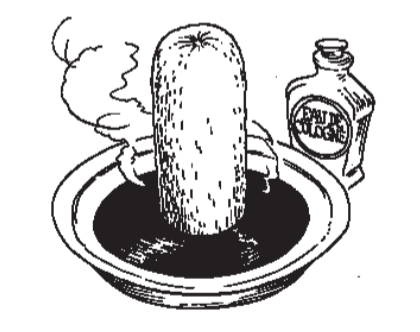THE MENU
SELECTED AND PREPARED
BY FUTURIST MARK BINELLI
AND FUTURIST MANUEL GONZALES
Primo Antipasto: “Aerofood”
Insalata: “Words-in-Liberty”
Secondo Antipasto: “Intuitive Antipasto”
Dolce: “Surprise Bananas”
Contorno: “Diabolical Roses”
Primo piatti: “Rice Oranges”
Secondo piatti: “The Jumping Askari”
Desserto: “Manandwomanatmidnight”
SOME CRUCIAL BACKGROUND ON FUTURISTS AND FOOD
The founder of Italian Futurism, Filippo Tommaso Marinetti, published the first Futurist manifesto in 1909, on the front page of Le Figaro. The poet and philosopher’s eleven-point program was a celebration of speed, new technology (particularly the automobile and the airplane), aggression, even war. Point Seven: “Except in struggle, there is no more beauty. No work without an aggressive character can be a masterpiece. Poetry must be conceived as a violent attack on unknown forces, to reduce and prostrate them before man.” Point Nine: “We will glorify war—the world’s only hygiene…” Point Eleven: “We will sing of great crowds excited by work, by pleasure, and by riot; we will sing of the multicolored, polyphonic tides of revolution in the modern capitals… bridges that stride the rivers like giant gymnasts, flashing in the sun with a glitter of knives…”
Marinetti and the Futurists believed that art, in particular, should be violent and disruptive, a destultifying experience. To that end, the Futurists tended to spread their ideas via outrageous public spectacles—from manifestos to literal brawls with critics to theatrical evenings that often ended with the performers being pelted with vegetables by enraged audiences. (Another early Marinetti manifesto: “The Pleasure of Being Booed.”)
Futurist painters such as Carlo Carrà and Giacomo Balla produced abstract, Cubist-influenced canvases which sought to capture and convey inherently dynamic energies—the key Futurist principles of velocity, movement, simultaneity, flight—in works such as, respectively, “The Funeral of the Anarchist Galli” (a violent depiction of a riot between police and mourners at the 1904 burial of a notorious Italian bomb thrower) and “Abstract Speed: The Car Has Passed.” Marinetti dubbed his colleagues “aeropainters,” while he himself produced “aeropoetry”: his best-known work being a highly experimental mergence of onomatopoeia and creative typesetting called Zang Tumb Tumb, published in 1914. Still, the form best suited to Marinetti’s overheated writing style remained the manifesto, and his often wildly diffuse rants survive as his most readable (and entertaining) work. For instance, in the fancifully titled “Let’s Murder the Moonlight,” Marinetti describes the blotting/slaying of the “ancient green queen of love” with the fires of three hundred lightbulbs. Other manifestos include “Down with the Tango and the Parsifal,”“We Abjure Our Symbolist Masters, the Last Lovers of the Moon,”“The New Religion-Morality of Speed,” and “Against Past-Loving Venice,” the Futurist term for “past-loving” (i.e. reactionary) being passéist.
There were also Futurist forays into music and...
You have reached your article limit
Sign up for a digital subscription and continue reading all new issues, plus our entire archives, for just $1.50/month.
Already a subscriber? Sign in





